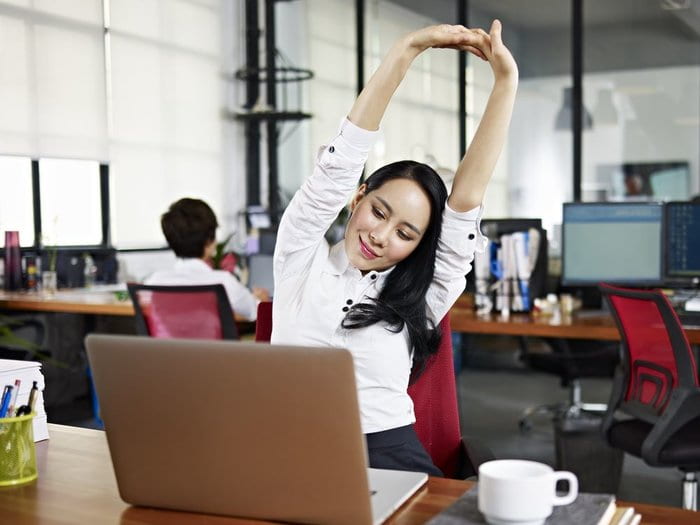
It was a long time ago when “work” meant engaging in physical labor and and actually leveraging your muscles to accomplish tasks. Most of us are spending 40+ hours a week sitting on bums doing all sorts of projects and when we’re done with work there’s of course the kids to worry about, and taking care of the dog, dinner, and endless hours commuting to and from work. With all these obligations you probably don’t have time for a gym membership, which is a problem because exercising is a major part of your fitness goals.
The good news is you don’t have to go to the gym to exercise. With these simple office workouts, you’ll be able to engage your muscles, burn calories, and over time your strength will increase and your energy levels will be much higher – improving efficiency and productivity. Here are 7 office exercises to get you started on your fitness:
1. Squats with office chair
Chair squats and regular squats are not very different. They are both designed to work the same muscles – glutes, hamstrings, and quadriceps – and you perform them with the same technique. The only distinguishing feature is the chair, which adds safety. To do a chair squat begin by standing up and place your feet apart at a comfortable space (about 12 inches), and point your toes forward with your arms comfortably hanging by your sides.
Push out your chest and shoulders to prepare your hips for the squat position, and stretch your arms straight out in front of you to provide balance as you squat. Squat until your bum is about a foot off the floor and most of your weight is on your heels, and then push yourself back up using mostly the heels, and then start again.
Put your arms back down as you stand up, and repeat 20 times. The chair is used as a safety feature when you feel wobbly from performing repeated moves, or in case you mess up your balance during the movements. It makes it harder to fall down or injure yourself when performing this exercise. If you want to reduce the thigh gap between your legs and shape them better, these squats really help
2. Neck stretch
The origin of neck pain can be hard to pinpoint. Could it be due to your bad posture and hours of texting, or a bad sleeping position? Neck muscles are woven down into our shoulders, so even the muscles in your shoulder girdle can affect the stiffness or mobility of your neck. To release tension, do this seated sequence:
Draw your chin down towards your chest, and take your left ear towards your left shoulder. From this position, lift your head slowly and gaze up at the ceiling, and then gently tilt your head back down until you feel a slight compression in the spine. Don’t drop your head so low as to force this compression. Relax your jaw, and bring your right ear towards your right shoulder and repeat this circle, alternating between the right side and left side. This move will help to release accumulated tension and relax your neck muscles.
3. Arm stretches
Raise your arms up over your head so that your hands reach toward the opposite side. Use one hand to grab your elbow and pull your elbow toward your head, and hold this position for 15-30 seconds. Repeat on the other side and hold for as long as comfortable.
4. Chair dips
Grab an office chair that is stable and won’t roll. Scoot up to the edge of the chair and stretch your legs out in front of you with hands firmly grabbing the edges of the chair on either side of you. Keep your fingers pointing forward and use your core and arms to raise your body up off the chair, and then down so that your bum comes close to the floor. Push yourself back up and repeat this move 10 times. Do three cycles of 10.
5. Hamstrings stretch
Sit down on the floor and stretch your legs out in front of you. Reach forward and extend your arms to grab your feet, and hold for 15-30 seconds. Keep your back straight as you bend forward and bend your waist down as far as possible, and relax back into the starting position. Do this move at least three times.
6. Upper body and arm stretch
To do an upper body stretch, clasp your hands up over your head with palms facing outward, and push your arms up as high as you can, lifting your shoulders in the process. Hold this position for 10-20 seconds.
7. Seated leg raises
Sit tall on the edge of your chair, and stretch out your legs. Lean back and raise your legs up, hold for 15 seconds and lower; and then repeat. You can also move your legs up and down as if you’re walking, and use your core to hold that position for 30-60 seconds.
Did you know?
Stretching in the workplace reduces tension in your joints, muscles, and it helps to improve posture while increasing your range of motion. It’s also a great way to boost blood flow and reduce stress.
